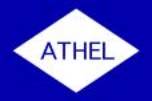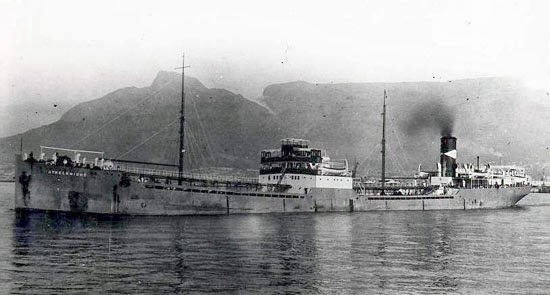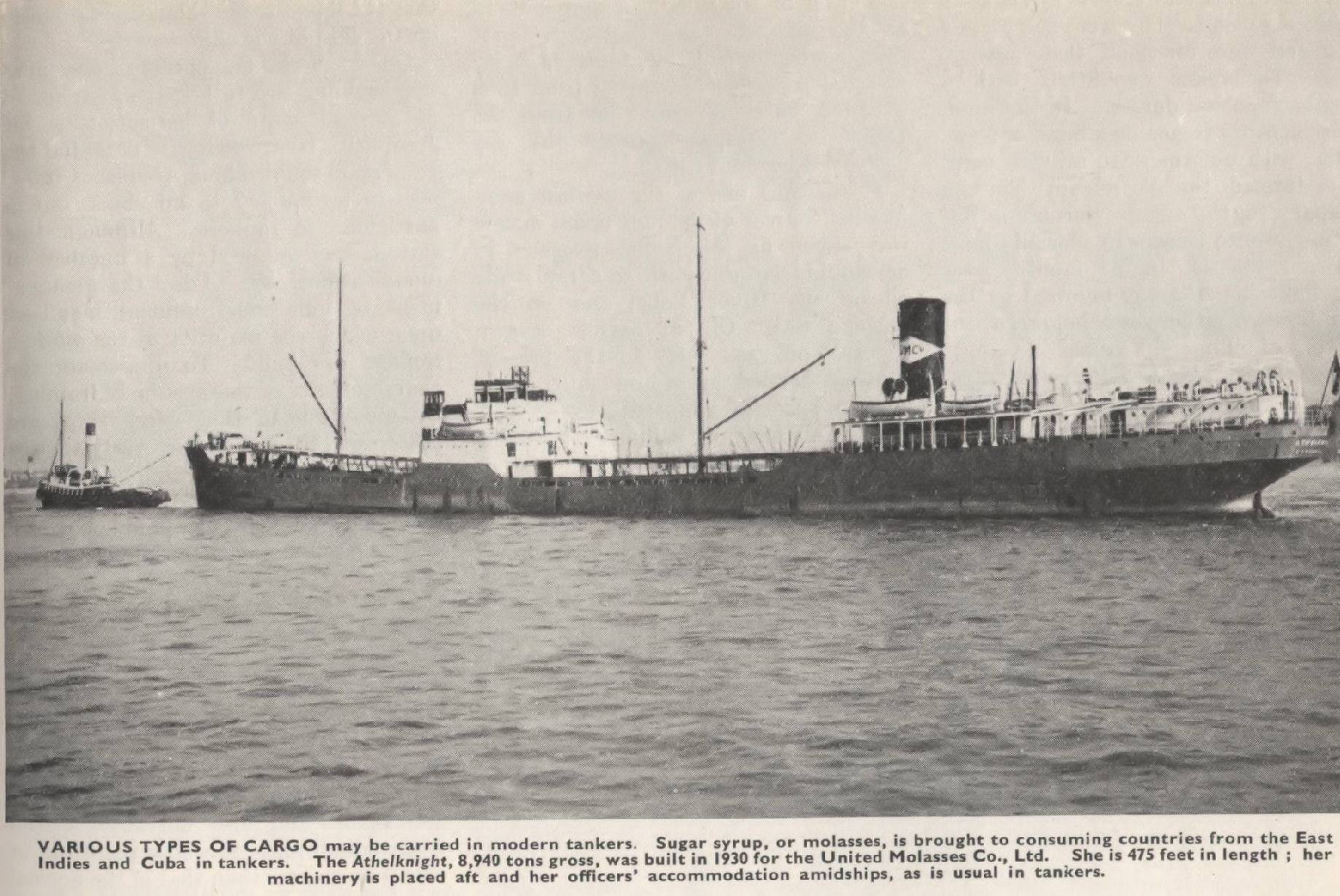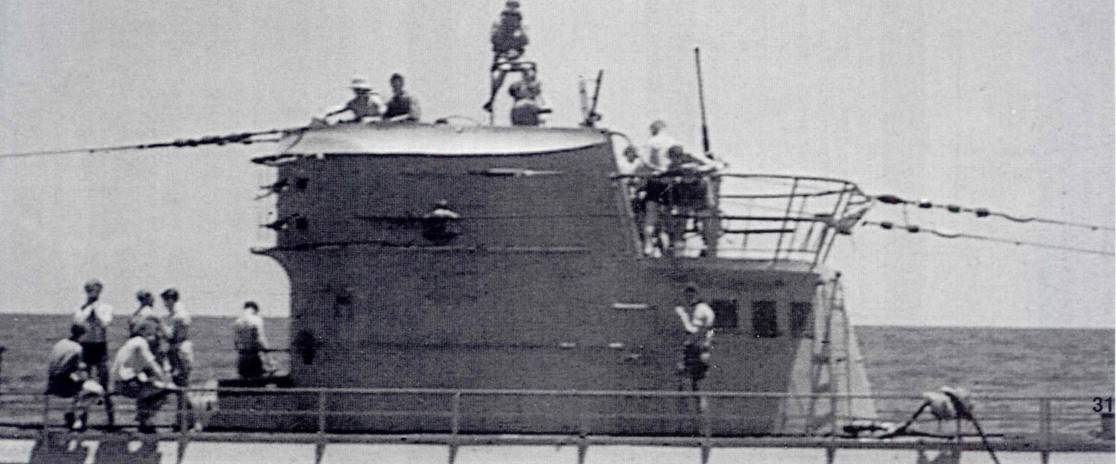|
CAPTAIN DOUGLAS CROOK, was a
Battle of the Atlantic veteran who achieved an epic feat of seamanship
as Second Officer of the tanker Athelknight, which was sunk by
U-172 (see below)
north-east of the Virgin Islands on May 27, 1942. The U-boat
surfaced alongside Crook's lifeboat, and its captain asked if there was
anything he needed. Crook said an extra bucket, food and medical
supplies. "He gave us the bucket and some fairly mouldy bread," Crook
recalled, "but said he couldn't spare any of his medical supplies."
Crook, in charge of a lifeboat with 26 survivors, decided he would make
for Antigua. He maintained the strictest discipline in the boat. "If
anyone was caught tampering with the fresh water, I promised personally
to chop his bloody fingers off." They drank condensed milk and water,
and ate pemmican and hard-tack biscuits, carefully rationed by Crook.
"The best we did was three fluid ounces a day," he recalled. "Eventually
we got down to an ounce of water a day. But there was no escaping the
sun. Some of the lads wanted to take a dip to cool off, but I refused
permission because I considered that they'd be too weak to get back on
board. "We became coated in salt, and as time passed our lips began to
suffer terribly." After 28 days and more than 1,000 miles, they reached
the French island St. Barthelemey, 100 miles north-west of Antigua, and
came ashore with water and rations to spare.
Crook was awarded an MBE,
not an over-generous award in the circumstances. Crook at once
volunteered to go to sea again, and won the George Medal and Lloyds War
Medal for bravery at sea later that year as Second Officer of the tanker
Scottish Heather.
Scottish Heather was equipped as an
oiler to refuel convoy escorts under way. She sailed with the
outward-bound convoy ONS154, which was badly mauled by two packs
of U-boats, 13 ships being sunk in a running battle which began on
Christmas Eve 1942. Scottish Heather was torpedoed by
U-225
on the night of the 27th and most of her crew, including the Captain and
the Chief Officer, took to the lifeboats. Crook was about to get into a
boat himself when he realised that the ship was not going to sink. He
called for volunteers, and took command of the ship. They raised steam,
got under way, recovered many of the survivors, including the Captain
and Chief Officer, and eventually reached the Clyde on Jan 2nd 1943.
Log of No. 4 Lifeboat (MV
Athelknight), kept by William (Bill) H. Cook, Third Officer.
Tuesday 26 May 1942
10:15pm. Torpedo hit on starboard
side in No. 6 tank. Captain came on bridge and ordered engines to
'Stop'. Chief Engineer came on bridge for instructions and Captain said
we would stand by with engines stopped & boats swung out.
Sub gave us about 10 mins. or ľ of
an hour before she struck us on port side with shell under the port
midships boat. Submarine kept ahead about 2 points on port bow ľ of a
mile so that we could not use our aft gun.
When sub started shelling Capt.
Roberts flashed a torch from the lower bridge but sub carried on
shelling so Captain ordered 'Abandon Ship'. We had tried to get a
wireless message out but everything in the W/T room was smashed.
Captainís boat was the first away and Senior Sparks and I were still on
the top bridge. I had gone back for my patrol jacket and cap from port
wing. Chief Officer was aft tripping rafts and attending to lowering of
Second Mateís boat.
Sparks and I went on lower bridge
and shells were falling near the port boat which three or four men were
attempting to lower. I told them to leave off and come with us to my
(port after) boat but they took no notice and Sparks and I went aft to
my boat. Second Mateís boat was clear of ship. Chief Officer had already
started lowering my boat away, and we cast off with 12 men aboard,
mostly my boatís crew, but some of them had gone in Captainís boat. Not
everyone had made for his own boat at the order ĎAbandon Shipí. The Mate
said that he would go back to his boat, but didnít. He came down into
mine.
We pulled away and the sub was
firing QF tracer shells over the boat. Port midships boat was now in the
water and the men were calling out to us that they were making water and
needed help. We pulled over to them thus putting ourselves in line of
fire from sub to ship. We were quite close to them when a shell struck
the ĎAthelknightí portside amidships and also port midships boats.
Shells were now falling thick and fast, and as there seemed to be great
danger of our boat being shelled too, we pulled away from the ship. Two
of our boatís crew were injured by either shell splinters or m.g.
(machine gun) bullets --- McAlinden, in face & Sheehan, in finger -- and
I got some in my left hand.
In pulling away we lost Dewar
fireman. He jumped or fell overboard but Chief Officer and I managed to
haul him back aboard again. The boat was making water fast and we had to
keep bailing continuously. Rowing was difficult for we had to keep
ducking down below the gunwale to miss the m.g. bullets which were
passing over the boat. We had some difficulty in steering because we had
a broken rudder pintle.
After a while the sub had moved to
the starboard side (of Athelknight) & the shelling had set the magazine
on fire. We could see the shells & cordite going off like fireworks. We
lay off the ship all night and some of us were violently sick.
Wednesday 27 May - Day 1
In the morning we could still see
the Knight about 2 miles away. She was on fire, but seemed to be
upright, so we decided to go back and if we couldn't get the ship
moving, we would take extra stores and a sextant and chronometer. On the
way back we saw what we thought was the Captain's boat & thought that
they must be making back for the ship too. But after we were a bit
closer we saw it was the submarine, so we sheared off to the NW where we
thought the Capt. & 2nd mate's boats must be.
At daybreak, the sub started
shelling the ship again, but must have found it slow work sinking her by
shell fire, for he soon gave her another torpedo which hit in the Engine
Room starboard side. She sank in a few minutes stern first and heeling
over to starboard. The last thing we saw was the foícísle head going
under. The Chief Engineer shed a few tears. He had served in the ship
for many years.
After a while we saw a sail and
rowing up to it found it to be the Second Mate & his crew with the
Captain and his crew. We were told the motor boat (no. 1) had been holed
when lowered on a jagged plate in No. 6 tank, so 2nd Officer had taken
the whole of No. 1 crew aboard his boat. They had also picked up the
damaged Mateís boat, No. 2 port midships, with 2 dead men and 3 badly
injured. 1 died a few hours later, shrapnel in the stomach. Moore O.S..,
Gaisford & McGrath A.B.s were dead.
We took 13 men on board our boat
making us 25 in all and leaving them 26, two of whom were severely
injured. The Captain told us the sub Captain had promised to radio our
position when he was clear of the area. The sub had given No. 3 boat a
bucket to bail with and several loaves of hard German black bread. The
Captain passed over 2 loaves to us. Arranged with the Captainís boat
to keep in touch if possible & flash a light at night....
Tried to keep Captainís boat in
sight but had lost a lot of way. Rudder had been shot to bits, and oar
is difficult to steer with. When darkness fell, we lost No. 3 boat
altogether. Continued rowing until about 10.00 pm and then packed up
and brailed sail for the night. Hands tried to sleep but not much
success owing to cramped positions.
|
Food Supplies in Lifeboat |
|
Item |
on May 26 |
on June 10 |
on June 26 |
| Biscuits |
35 (16-oz) tins |
22 tins - ration cut from 1
to 1/2 biscuit per meal. |
4 tins |
| Milk Tablets |
35 (16-oz) tins
(1 tablet = 1/3 oz) |
29 tins |
16 tins |
| Pemmican |
97 (6-oz) tins (1 level
teaspoon = 1/6 oz) |
79 tins |
23 tins |
| Condensed Milk |
48 (14-oz) tins |
21 tins |
16 tins |
| Chocolate |
35 (16-oz) tins (1 piece =
1/5 oz) |
21 tins |
2 tins |
| Drinking Water |
Got an extra 8
gals. from an abandoned raft. Later made an awning to catch
rainwater. |
| |
|
|
|
Thursday 28 May - Day 2
4.00am. Breeze freshened
from ENE. All sail set and proceed course WSW. true. Lost steering oar.
It's hard to judge speed but I should think we're doing 3-4 knots in
this good breeze.
Breakfast 7:00 am - 1
bisc. 2 choc. 2 milk tablets, 2-oz water.
Dinner noon - 1 bisc. 1 tsp pemmican, 2 milk tablets, 2 1/2 oz. water
Tea 6.00 pm. 1 bisc. 1 tsp. pemmican, 2 milk tablets, 2 chocs., 3 oz.
water.
Day ends with gentle
breeze ENE. Compass WSW true.
Monday 1 June - Day 6
Ready-made cigarettes are
gone, also cigarette papers. There are 4 lbs. of shag tobacco and a few
plugs aboard, so we are using shag tobacco and pages of Nautical Almanac
for rolling cigarettes. Nautical Almanac is of no use to us, for we
have not a sextant aboard.
Thursday 4 June Day 9
. 0300 heavy rain
commenced and continued until 0700. Collected 14 gallons and refilled
empty service tanks.
Monday 8 June Day 13
. Issued the milk myself
today, and used about 2/3 of a tin, against 1 Ĺ tins when I passed the
tin round for each man to help himself.
Thursday 11 June - Day
16
What a stench there is in
the boat, 25 men havenít had a bowel movement for 17 days and all packed
in a boat like sardines in a tin.
Saturday 13 June Day 18
Men are complaining
about there being no issue of condensed milk for last 3 days, but weíll
have to cut down rations still more if these calms continue. All hands
in water about six times today.
Sunday 14 June - Day 19
Checked stores again, and
have about enough for 12 days if we cut them by half again.
Wednesday 17 June - Day
22
Everyone feeling weak and
thirsty now. Some of the men are drinking salt water, but if one stops
them during the day, they drink twice as much at night time.
Sunday 21 June - Day 26
Opens cloudy, calm &
smooth sea.
Breakfast: 1/2 bisc; 1
choc; 2 milk tablets; 1 tsp brandy; 1 oz water; 1/6 oz pemmican
Dinner noon: 1/2 bisc; 1 choc; 2 milk tablets; 1/6 oz pemmican; 1 oz
water.
1400 approx. sighted
ship. Picked up by SS 'Empire Austin', bound for Capetown. All hands
aboard by 3:45 and lifeboat sunk.
In Capetown, the Chief
Officer requested a copy of the log. An edited copy was made and given
to him before we left Capetown for Glasgow aboard the 'Warwick Castle'.
Fate of U-172 a type 9C. Sunk 13 December, 1943 in the
mid-Atlantic after
a 27 hour fight west of the Canary Islands, in position 26.29N, 29.58W, by
depth charges and
Fido homing
torpedoes from Avenger and Wildcat aircraft (VC-19) of the American escort
carrier USS Bogue and by some 200 depth charges from the US
destroyers USS George E Badger, USS Clemson, USS Osmond
Ingram and USS DuPont. 13 dead and 46 survivors.
http://www.uboat.net and also
http://www.ubootwaffe.net/ops/ships.cgi?boat=172;nr=1 |



